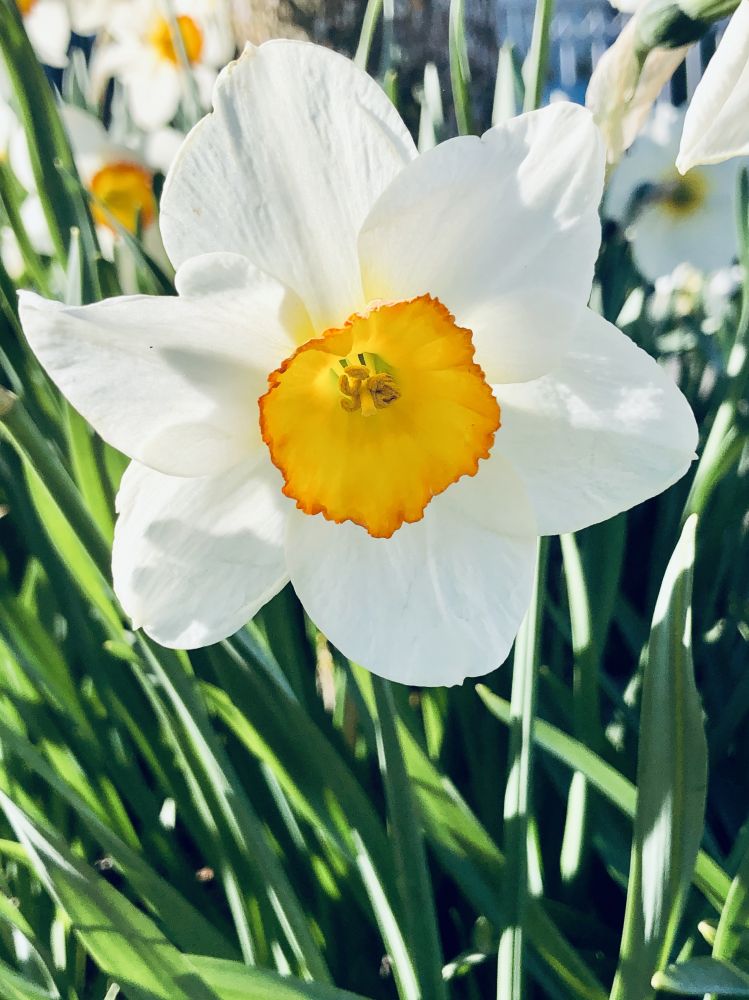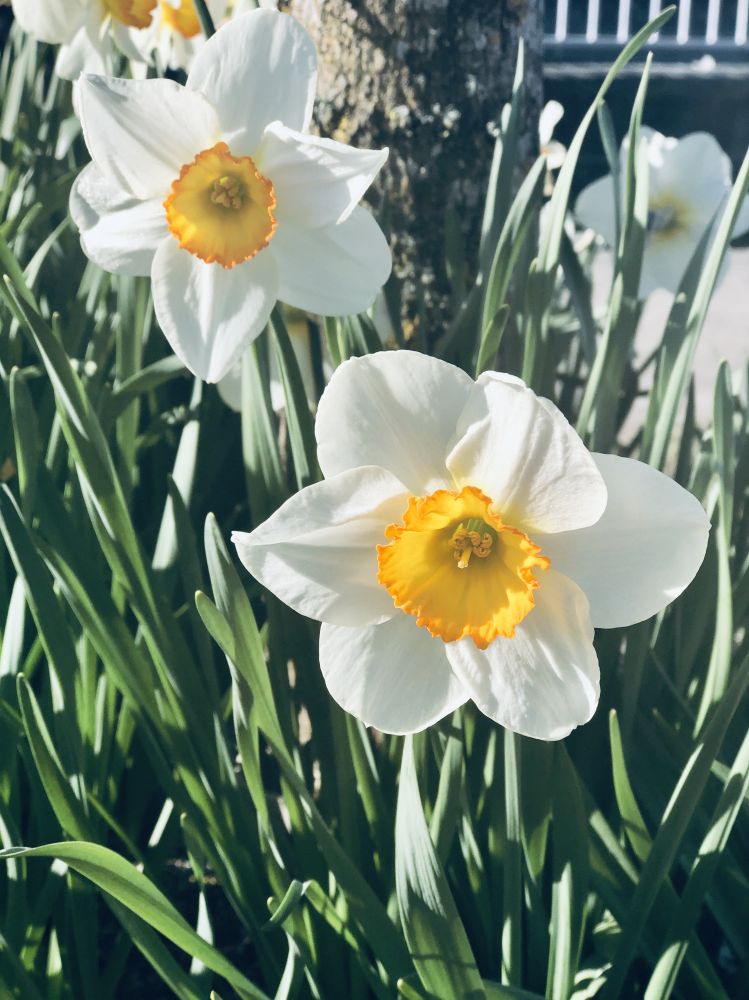(三)古希臘文學作品裏的水仙花
出現在希臘神話裏的水仙花到底是哪些品種呢?
西方專家們認為最大的可能性是紅口水仙(Narcissus poeticus,俗名poet's narcissus,詩人的水仙),其次為多花水仙(Narcissus tazetta)。


(紅口水仙)
紅口水仙原產法國至土耳其一帶,株高40-55厘米,四月開花,花單生,花色潔白,副冠呈淺杯狀,黃色,杯的邊緣為橙紅色皺邊,故名“紅口水仙”。花香怡人,從中提取的精油可用來製作香水。
多花水仙原產於從葡萄牙至土耳其一帶的地中海地區,是個頭最高的水仙之一,可達80厘米,每球有花葶數支,多者可達10餘支。每葶數朵至10餘朵花,組成傘房花序,花瓣潔白芬芳,有黃色杯狀的副冠。中國的水仙花就是多花水仙的亞種(Narcissus tazetta subsp. Chinensis),唐朝時從意大利引進的。


(多花水仙)
長久以來,水仙花是一種美麗的裝飾花卉,古埃及的墳墓裏和意大利龐貝古城殘餘的壁畫上都出現了多花水仙。從《荷馬史頌》裏的《致得墨忒耳》篇關於水仙花的描述來看,用來引誘珀耳塞福涅的很有可能是多花水仙,因為“從它的根部長出一百朵花”,符合多花水仙的特征。許多專家認為納西索斯死後化成了紅口水仙,後世歌詠納西索斯的詩篇很多,因而該水仙又被稱為“詩人的水仙”。
古希臘詩人斯塔西諾斯(Stasinos)在他的史詩《庫普裏亞》(Cypria)(大約創作於公元前七世紀末或六世紀)提到了水仙花: “她穿著上天和時光為她做的衣服,用春天的花染色-這些花作為當季的著裝-番紅花、風信子、蓬勃的紫香堇和可愛的玫瑰花,如此甜美可口,還有美妙的鱗莖花卉,水仙和百合。阿佛洛狄忒(即愛神)一年四季穿著這種香氣濃鬱的服裝。”
(She clothed herself with garments which the Graces and Hours had made for her and dyed in flowers of spring -- such flowers as the Seasons wear -- in crocus and hyacinth and flourishing violet and the rose's lovely bloom, so sweet and delicious, and heavenly buds, the flowers of the narcissus and lily. In such perfumed garments is Aphrodite clothed at all seasons)
古希臘劇作家索福克勒斯(Sophocles,公元前497年-公元前406年,古希臘悲劇的代表人物之一)在作品《俄狄浦斯在科羅諾斯》(Oedipus at Colonus)寫了一首與水仙花有關的歌:“而且,水仙以天上的露水為食,美麗的花簇朝朝開放。它是兩位偉大女神的古老王冠。 番紅花綻放著金色的光芒。基菲索斯河川流不息,每天奔過大地胸前,用清泉灌溉平原,使土地肥沃。跳舞的繆斯不會離開這個地方,那個手持金色韁繩的阿佛洛狄忒也不會厭棄。”
(And, fed on heavenly dew, the narcissus blooms day by day with its fair clusters; it is the ancient crown of the Great Goddesses. And the crocus blooms with a golden gleam. Nor do the ever-flowing springs diminish, from which the waters of Cephisus wander, and each day with pure current it moves over the plains of the land's swelling bosom, bringing fertility. Nor have the dancing Muses shunned this place, nor Aphrodite of the golden rein.)
索福克勒斯以水仙來隱喻生育力,並將它同得墨忒耳和珀耳塞福涅兩位女神聯係在一起。因珀耳塞福涅是冥後,水仙又象征著死亡。 近代著名的希臘語教授理查德.傑布(Richard Claverhouse Jebb,1841 – 1905) 曾經這樣評論:水仙是死亡之花,它的香氣有麻醉作用,以淡白為主色。就像珀耳塞福涅伸手摘水仙預示了她的厄運一樣,納西索斯凝視著自己的倒影預示了他的死亡。
古希臘詩人莫斯霍斯(Moschus,約活動於公元前2世紀前後)流傳至今的《田園詩》(Idylls)裏,我最熟悉的是《歐羅巴》(Europa)一節。歐羅巴是美麗的腓尼基公主,與一群姑娘在長滿鮮花的草地上玩耍。宙斯化身一頭漂亮的小公牛,把歐羅巴劫持到克裏特島為所欲為。詩中是這樣形容宙斯誘騙歐羅巴的情形的:
“現在,女孩們一來到開花的草地,立刻喜歡上了各種各樣的花,其中一個女孩摘了甜香的水仙,一個女孩采了風信子,一個女孩采了紫香堇,還有一個女孩采了匍匐百裏香,草地上落著許多帶著春天氣息的花瓣。其他人又在競相收集著黃色番紅花芬芳的毛發(即花柱頭)。但是在她們中間,公主像緋紅的玫瑰那樣光彩照人,又像從泡沫裏誕生的女神一樣豔壓群芳。的確,很長一段時間她都沒有將心中的喜悅放在花朵上,是的,也很長一段時間都沒有碰過她的少女腰帶。確實,克羅諾斯的兒子一見到她就心動了,他的心突然被塞浦路斯女神的杖柄控製住了,隻有塞浦路斯女神才能征服宙斯。因此,為了避免善妒的赫拉的憤怒,並急於欺騙少女的一顆純真心,他隱瞞了自己的神格,換了形象,變成一隻公牛。不是那種在牛圈裏吃食,劈溝拉犁的牛,不是那種在草地上吃草的牛,也不是那種被束縛於軛下、拉著沉重車子的牛。不,盡管他的身子是亮栗色的,但眉毛之間有一個亮銀色圓圈,他的眼睛微微發亮,閃現欲念之光。從他的額頭上伸出均勻的長角,如有角的月牙似的,就像月亮被劈成了兩半。他來到草地上,所有的姑娘們都不感到害怕,而是激起了接近這頭可愛的公牛並觸摸他的渴望,他天堂般美妙的香氣散布在遠處,甚至超過了草地上的花草香。然後他站在漂亮的歐羅巴麵前,一直舔著她的脖子,向她施咒。她依舊愛撫著他,用她的雙手輕輕擦去了他嘴唇上深沉的泡沫,親吻了他。然後他輕輕地叫著,您會以為聽見了彌格多尼安人的長笛發出的柔和之聲。”
(Now the girls, so soon as they were come to the flowering meadows, took great delight in various sorts of flowers, whereof one would pluck sweet-breathed narcissus, another the hyacinth, another the violet, a fourth the creeping thyme, and on the ground there fell many petals of the meadows rich with spring. Others again were emulously gathering the fragrant tresses of the yellow crocus; but in the midst of them all the princess culled with her hand the splendour of the crimson rose, and shone among them all like the foam-born goddess among the Graces. Verily she was not for long to set her heart’s delight upon the flowers, nay, nor long to keep untouched her maiden girdle. For of a truth, the son of Cronos, so soon as he beheld her, was troubled, and his heart was subdued by the sudden shafts of Cypris, who alone can conquer even Zeus. Therefore, both to avoid the wrath of jealous Hera, and being eager to beguile the maiden’s tender heart, he concealed his godhead, and changed his shape, and became a bull. Not such an one as feeds in the stall nor such as cleaves the furrow, and drags the curved plough, nor such as grazes on the grass, nor such a bull as is subdued beneath the yoke, and draws the burdened wain. Nay, but while all the rest of his body was bright chestnut, a silver circle shone between his brows, and his eyes gleamed softly, and ever sent forth lightning of desire. From his brow branched horns of even length, like the crescent of the horned moon, when her disk is cloven in twain. He came into the meadow, and his coming terrified not the maidens, nay, within them all wakened desire to draw nigh the lovely bull, and to touch him, and his heavenly fragrance was scattered afar, exceeding even the sweet perfume of the meadows. And he stood before the feet of fair Europa, and kept licking her neck, and cast his spell over the maiden. And she still caressed him, and gently with her hands she wiped away the deep foam from his lips, and kissed the bull. Then he lowed so gently, ye would think ye heard the Mygdonian flute uttering a dulcet sound.)
作者將歐羅巴公主的美與從泡沫裏誕生的女神阿佛洛狄忒相媲美。阿佛洛狄忒是從天神烏拉諾斯的陽具拋在海中所化成的泡沫裏誕生的,姿容非凡,美貌征服了奧林匹斯聖山上的眾神,連宙斯都追求過她,遭到了拒絕。詩歌中的塞浦路斯女神就是愛神阿佛洛狄忒的別稱。阿佛洛狄忒擁有一條金色的愛情腰帶,其中隱藏著她誘惑他人的秘密,隻要將腰帶戴在腰上,就能增長自身的魅力,勾起他者的注意力和情欲。 歐羅巴雖和阿佛洛狄忒一樣美麗,卻純真無暇,不知道用自己的魅力去“勾引”男人,所以“很長一段時間都沒有碰過她的少女腰帶”。阿佛洛狄忒身為愛神,但卻無法支配自己的權能,她總是被命運捉弄著,得不到屬於自己的真愛。歐羅巴公主也一樣,她被宙斯誘奸,又被他帶到了克裏特島。她最後屈服了,和宙斯生下三個孩子,因此歐羅巴被稱作歐洲最初的人類,也就是說,歐洲人全都是這位腓尼基公主的後裔。
腓尼基是古希臘人對地中海與黎巴嫩山脈之間那塊狹長地帶的稱呼,其地理位置包括今天的黎巴嫩、敘利亞南部與以色列北部。那一帶生長著多花水仙花,歐羅巴在草地上采的極有可能就是這種水仙花。




